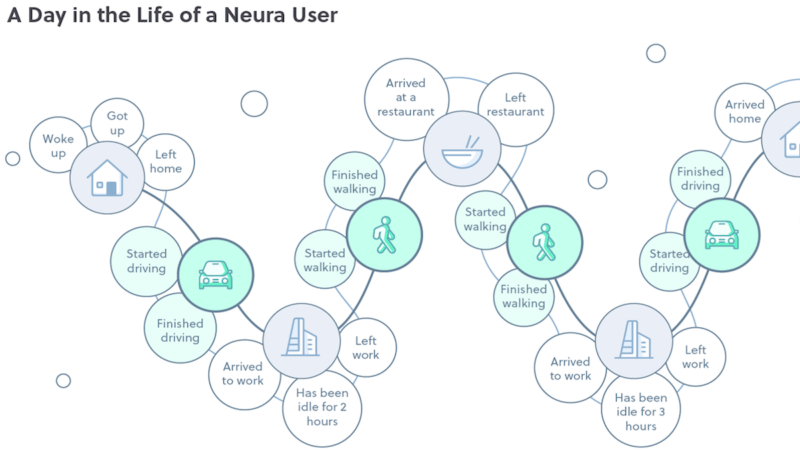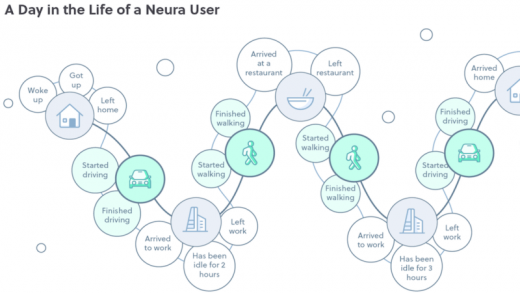Neura and In Loco are launching new efforts to tap the real world for targeting
These startups are pointing to ways in which the Internet of Things, data mashups and predictive inferences are helping marketers move beyond online indicators.

From Neura
Two companies are expanding ad and content targeting techniques that employ new ways of tapping the real world.
Sunnyvale, California-based Neura and Brazil-based In Loco use different techniques, but both are pointing to how non-web tracking could evolve.
After three years of development and two years of availability only to a selected group of client companies, Neura has launched its Moments to the public.
The idea of “moments” is not uncommon among mobile ad tech companies, such as FollowAnalytics, MediaBrix or MobileFuse, where the emphasis is on positioning “the right message at the right time” within actual real-world activities. An ad for a nearby bar, for instance, might be delivered to a smartphone when location data indicates the user is at a nighttime ballgame in the last inning.
But that is mostly web- and location-based data, sometimes combined with external maps or weather info. Instead, Neura CEO Amit Hammer told me via email, Neura’s main differentiator is that it uses triggers from the real world to define personas and to predict behavior:
Neura chooses not to look at your web behavior, read your emails, or track your Facebook profile. Our technology does not listen to your microphone or take photos with your camera; Neura does not collect any intrusive or personal data.
Our innovative approach is different — Our machine learning algorithms are able to transform ambient sensory data into anonymized real-world actionable insights, provided back to our customers, under user consent, allowing their products to adapt to each user’s [preferences] and react to key moments throughout their day.
The data comes via the Neura Software Development Kit, utilized in cooperating apps where the user has granted consent. It arrives from more than 50 sensors on the phone — such as gyroscopes or ambient light detectors — or from Internet of Things devices like smart thermostats.
The messaging is delivered through the app based on these perceived real-life triggers, such as a digital health app that lets the user know when it’s time to take a pill because the sensory data indicates the user has just awakened.
The participating apps can be both free or paid, Hammer said, such as ones relating to weather, and the user grants consent that Neura says is compatible with the General Data Protection Regulation (GDPR). Although Hammer declined to say how many apps are participating, he did say it was “dozens,” adding that about 40 unnamed brands are customers in the US and Europe.
In Loco, which has announced it is now launching into the US from its home base in Brazil, is similarly expanding the scope of signals received from the real world.
It geotracks users by generating a location map that doesn’t use GPS or beacons, and which it says is 30 times more accurate than GPS.
As Neura does, In Loco tracks the signals through apps from cooperating app developers, for which users have granted consent in order to receive more targeted ads or more personalized content.
There are several sources of data. An identifier for the nearest WiFi hotspot determines a general position, with the signal strength establishing distance from the hotspot.
The smartphone’s magnetometer and compass are employed in tandem to reveal magnetic distortion that indicates a nearby presence of a significant amount of metal, such as steel shelves, which can then be used as a reference point. The smartphone’s accelerator and gyroscope help define the user’s path by indicating speed and direction.
This tracking data is meshed with floor plans offered by retailers, such as Walmart’s. A detailed “fingerprinting” of the space can help In Loco track, for instance, whether users who have been exposed to ads for a given product visit that product on Aisle 3 within a week of the ad.
CEO André Ferraz told me that about 300 retailers in Brazil have provided such maps, as have American retailers and third-party suppliers of place data. His company has “fingerprinted maps” of varying degrees of resolution for about 25 million venues worldwide, of which about 12 million are already in the US, thanks to partnerships.
Mapping these venues with beacons, he noted, would cost about $5 billion, but his company has spent “only server costs, about $200,000.” He noted that GPS coverage inside stores can be spotty at best, and added that In Loco’s solution requires less battery consumption in a smartphone than GPS does.
The resulting data is used to target in-app ads to aggregated segments of users via In Loco’s ad network, to provide personalized in-app content that will increase engagement, to track costs-per-visits for foot traffic resulting from ad campaigns, and for matching ads to nearby billboards. In the latter use case, an in-app ad might repeat the messaging in a nearby static or digital billboard.
The key competitor to his company’s approach, Ferraz said, is Indoor Atlas, which he said primarily uses the technique for navigation, not marketing. But the competition will only increase for both In Loco and Neura, as the real world pumps out more and more useful information.
Marketing Land – Internet Marketing News, Strategies & Tips
(10)



